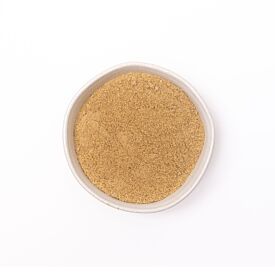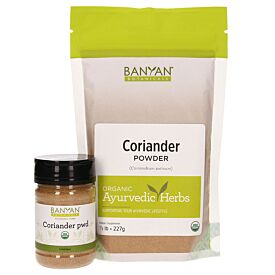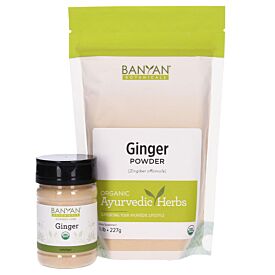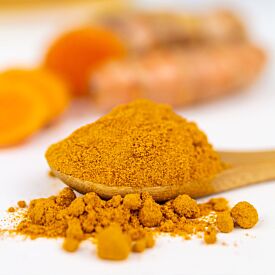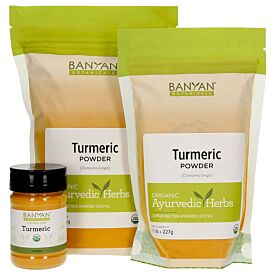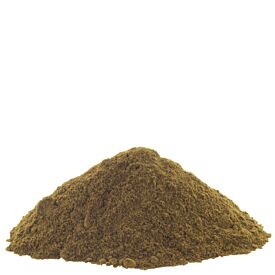8 Spices to Try This Fall and Winter
When the days start to get shorter, breezes become cooler, and leaves crunch beneath your feet, there’s no denying that a change of season is underway. As we transition into fall and winter, we intuitively gravitate to warmer, heavier foods. We may also notice changes to our body—inside and out—including some imbalance.
All of this makes it a wonderful time to add more spice to your life. After all, spices not only give flavor to our food, but have properties that can support our digestion and promote overall health.
What’s So Great About Spices?
Spices have been used in Ayurvedic cooking for thousands of years for a variety of reasons. To begin with, they help us feel more satisfied by contributing a diversity of tastes to our diet, and they provide an easy way to create meals that have all six tastes (sweet, sour, salty, bitter, pungent, and astringent) in a proportion that supports our individual constitution and current state of balance.
Using spices is also an excellent way to engage our many senses as we eat, which brings our awareness into the present moment and contributes to mindful eating. This attentiveness, combined with the beneficial properties of the spices themselves, supports optimal digestion and the body’s ability to absorb nutrients.
The warming, cleansing, and stimulating qualities of spices help eliminate ama (natural toxins) that can hinder the body’s optimal function, ultimately promoting a healthy, robust immune system and a sense of overall vitality.
Lastly, each spice offers unique and potent qualities which—when used skillfully—can support our journey towards greater health and balance.1, 2, 3
Spices to Savor in Fall and Winter
According to Ayurveda, fall and early winter have qualities that are very similar to vata dosha, including cold, dry, light, rough, subtle, clear, and mobile. As these qualities increase in the environment, they tend to increase in our bodies as well.
These qualities may show up as dry skin, changes in appetite, slower digestion, weight gain, discomfort in the muscles and joints, restlessness, anxious feelings, and trouble sleeping. Consuming foods and drinks that bring opposite qualities is an excellent way to counter the effects of this season—which is why heavier, warmer choices and flavorful spices are ideal.
Let’s explore eight spices that tend to be supportive for all body types and doshas (vata, pitta, and kapha) during the fall and early winter. Keep in mind that moderation is key since many spices can aggravate pitta if used in excess, and if you have any medical conditions, it’s always important to first learn about any possible contraindications of a spice and to work with your practitioner.
1. Black Pepper
Black pepper, also known as kalimirch in Sanskrit and by its botanical name Piper nigrum, is a spice that has a hot, pungent taste as well as warming, drying, and stimulating qualities. It supports the circulatory, digestive, and respiratory systems. For example, black pepper promotes hunger, absorption of nutrients, and healthy elimination, while supporting the lungs and removing ama from the body.
Serving Ideas:
- For maximum freshness, buy whole black peppercorns and grind before use.
- Add to soups, vegetables, rice, sauces, aloe vera juice, or warm water.
- Add two pinches of black pepper to one teaspoon of honey to soothe the throat and lungs and help clear accumulated ama in the respiratory tract.
- Add a pinch of black pepper to a teaspoon of ghee to soothe a hoarse, tired voice.4 5, 6
2. Cardamom
Cardamom, also known as elaichi (Sanskrit) or Elettaria cardamom (botanical name), is a sweet, slightly pungent spice. It supports healthy digestion by countering an unsettled stomach, bloating, gas, and indigestion, and supports healthy coronary circulation. It also promotes fresh breath, calms hiccups, and can help soothe the respiratory tract.7, 8, 9
Serving Ideas:
- Add cardamom powder to oatmeal, baking recipes, sweet potatoes, sweet sauces, rice pudding, or on top of fresh fruit.
- Drink it in warm almond milk, water, or tea. As a tea, it pairs well with cinnamon, cloves, and ginger.
- Enjoy it as a part of traditional Ayurvedic preparations like sitopalādi and tālīsādi.
- Chew on whole cardamom seeds to support fresh breath.
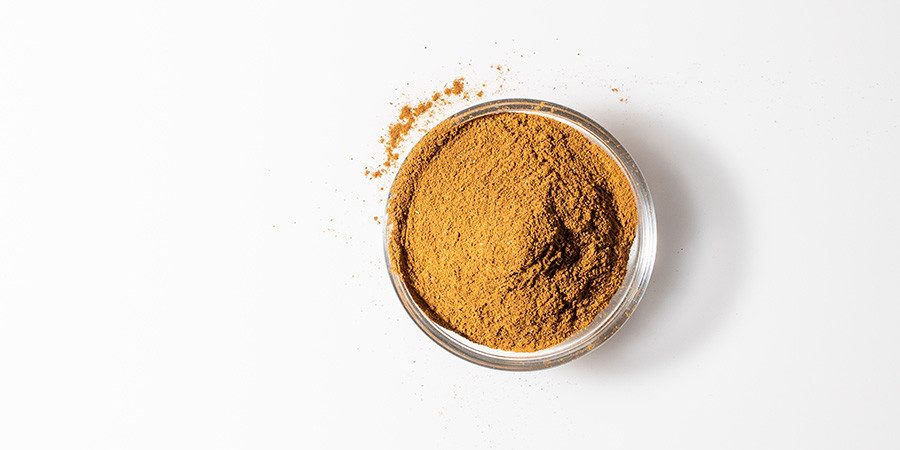
3. Cinnamon
Cinnamon, also known as dāru-sitā, twak (Sanskrit), and Cinnamomum cassia (botanical name), is a wonderfully aromatic and beneficial spice that comes from the bark of a cinnamon tree. It gives food a pungent, slightly sweet, and bitter taste.
Consuming cinnamon supports the body’s digestive, circulatory, urinary, nervous, and reproductive systems, as well as the blood and nerves. It is often used to bolster the appetite, eliminate ama, and bring warmth to the body.10, 11, 12
Serving Ideas:
- Use cinnamon to flavor oatmeal, sweet dishes, baked goods, pudding, rice, soup, and vegetables.
- Add ¼ teaspoon of cinnamon powder and ¼ teaspoon of dried ginger to a teaspoon of honey to soothe the respiratory tract and clear excess mucus. Or add it to boiling water to drink as a warm tea.
- Use in combination with cardamom and ginger to promote regular elimination.
- Enjoy it as a part of traditional Ayurvedic preparations like sitopalādi and tālīsādi.
- Apply cinnamon oil to teeth, gums, head, and joints to support comfort.
- Use cinnamon flavored Daily Swish to support oral health.13, 14
4. Cloves
Also known as lavanga (Sanskrit) and Syzgium aromaticum (botanical name), cloves are dried, unopened buds from an evergreen tree that offer a pungent, bitter taste. Consuming cloves supports healthy digestion, appetite, the immune system, reproductive health, and lung clarity and function. They help relieve gas and support comfortable digestion, and when applied topically, cloves promote comfort for the teeth and gums.15, 16, 17
Serving Ideas:
- For maximum freshness, buy whole cloves and grind before use.
- Add to boiling water to drink as a warm tea. Add cardamom, cinnamon, and ginger for a warming, invigorating blend.
- Add ground cloves to your morning oatmeal along with cooked, spiced fruits.
- Flavor rice with cloves as well as cinnamon, bay leaves, and black pepper.
- Add cloves to curry recipes, vegetables, sweet dishes, and pudding.
- Add them to other dishes that call for spices like cinnamon, nutmeg, cumin, turmeric, and coriander.
5. Cumin
Cumin, also known as jīraka (Sanskrit) and Cuminum cyminum (botanical name), is an aromatic spice that’s commonly used in seed or powder form, providing a pungent and mildly bitter taste. In addition to supporting the absorption of nutrients, removal of ama, and healthy digestion, cumin is also used to clear excess mucus, promote breastmilk production, and support comfortable menstruation.
Serving Ideas:
- Drink as a warm CCF Tea—cumin, coriander, and fennel—or simply mix cumin powder with warm water.
- Chew on cumin seeds after a meal to support digestion.
- Use cumin powder or seeds to make a curry or season rice, kitchari, vegetables, and soups.
- Sautée cumin seeds with ghee to release their flavor.
- Use with cardamom, fennel, and coriander to support digestive health.
- Use with fresh ginger to support comfortable menstruation.
- Use with ginger, licorice, and pippali to support expectoration of coughs.18, 19, 20
6. Ginger
Also known as ārdraka (Sanskrit) and Zingiber officinale (botanical name), fresh ginger root offers a pungent, sweet taste and is known in Ayurveda as the “universal medicine.” It can support healthy lung function, calm hiccups, and promote comfortable menstruation. It also supports nutrient absorption, healthy digestion, removes ama, and increases circulation.
Fresh ginger is calming and soothing for excess vata. Dry ginger powder is energetically hotter, making it a great choice for balancing kapha.
Serving Ideas:
- Make your own ginger tea with warm water and fresh ginger root, or add ginger to CCF Tea.
- Add to baked goods, curry, vegetables, soup, and stir-fry.
- Use with cinnamon and lemongrass to keep digestion and the immune system strong.
- Use with pippali to support the health of the lungs and respiratory tract.
- Use with turmeric and rose to promote comfortable menstruation.21
7. Nutmeg
Nutmeg, also known as jātī-phala and mada-śaunda (Sanskrit), and Myristica fragrans (botanical name), is an aromatic spice that is actually the kernel of the fruits of an evergreen tree. It offers pungent, bitter, and astringent tastes. Along with adding incredible flavor, nutmeg is used to promote a calm mind, concentration, sound sleep, fresh breath, muscle and bone strength, and reproductive health. That’s all in addition to enkindling the appetite, removing ama, and supporting healthy digestion.
Serving Ideas:
- Flavor dessert recipes, baked goods, soups, and rice with nutmeg.
- Add it to warm almond milk before bed to support relaxation, sleep, and stillness.
- Use with amalaki, haritaki, kutki, fennel, and cardamom to support comfortable digestion.
- Use with ashwangandha, brahmi, and jatamansi to promote sleep and stillness.
- Use with ashwangandha, gokshura, and lotus seeds to support male fertility
- Use with rose and shatavari to support regular menstruation and female fertility.
- Mix a pinch of nutmeg with ghee to calm an unsettled stomach.
- Make a nutmeg paste and rub on the forehead or joints to help support comfort in these areas.22, 23, 24
8. Turmeric
Last but certainly not least, we have turmeric, a common spice that’s widely used in Ayurveda. Also known as haridrā (Sanskrit) and Curcuma longa (botanical name), it provides pungent, bitter, and astringent tastes. In addition to enkindling the digestive fire and removing ama, turmeric supports liver and heart health, blood purification, healthy blood sugar levels, mental clarity, healthy skin and complexion, bone health, healthy menstruation, breast health, and breastmilk production. It can also be used to comfort and nourish the throat.
Serving Ideas:
- Add turmeric powder to vegetables, rice, beans, lentils, potatoes, and curry. It combines well with many other spices, so feel free to get creative.
- Drink in warm water, almond milk, or as part of a delicious Turmeric Milk recipe.
- Use with guggulu, musta, and punarnava to support balance of the lower abdomen and menstruation.
- Use with ginger, licorice, and cloves to soothe the throat.
- Mix with warm salt water and gargle to support a comfortable throat.
- Apply topically to promote healthy skin and bring comfort to the joints. Use with care since turmeric can stain fabric and skin.25, 26, 27
Additional Tips for Enjoying Spices
With all of the wonderful ways that spices support us during fall and winter, now is a great time to stock up. Because Ayurveda believes in bio-individuality and each person’s constitution is unique, it’s also important to consult your practitioner before making changes to your diet.
As you add in these spices, do so in moderation, note how they make you feel, and don’t be afraid to expand your palate to tap into the power of other herbs and spices as well. May they bring health, balance, and a little extra spice to your life!




